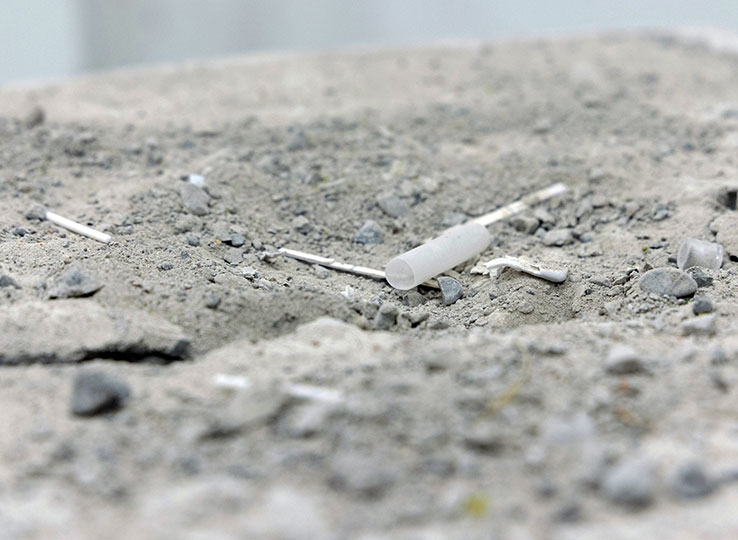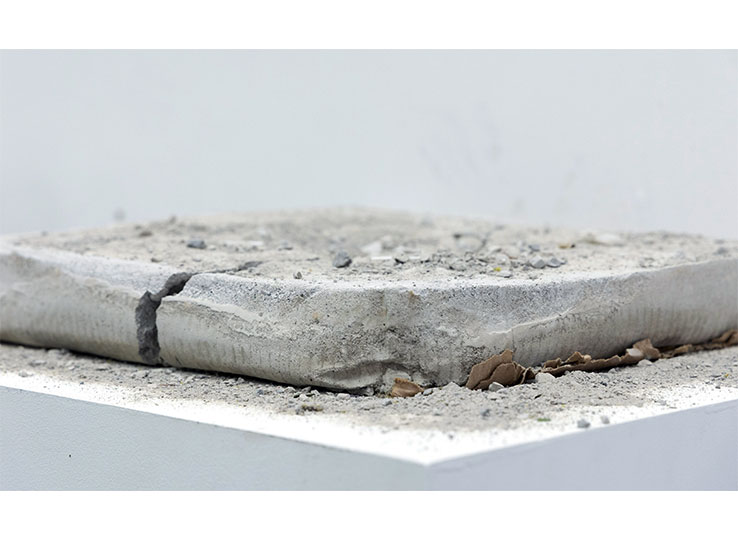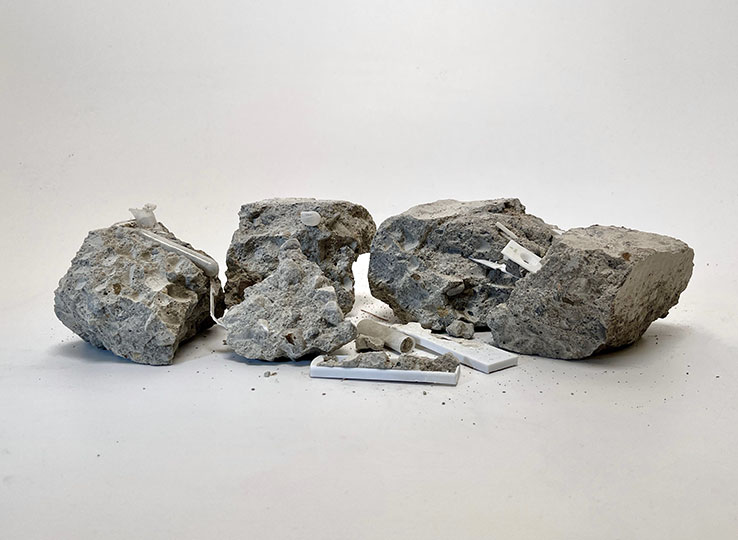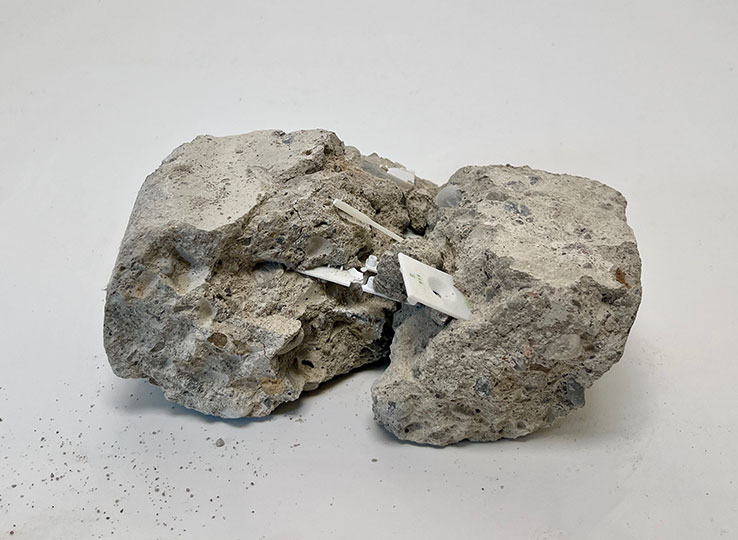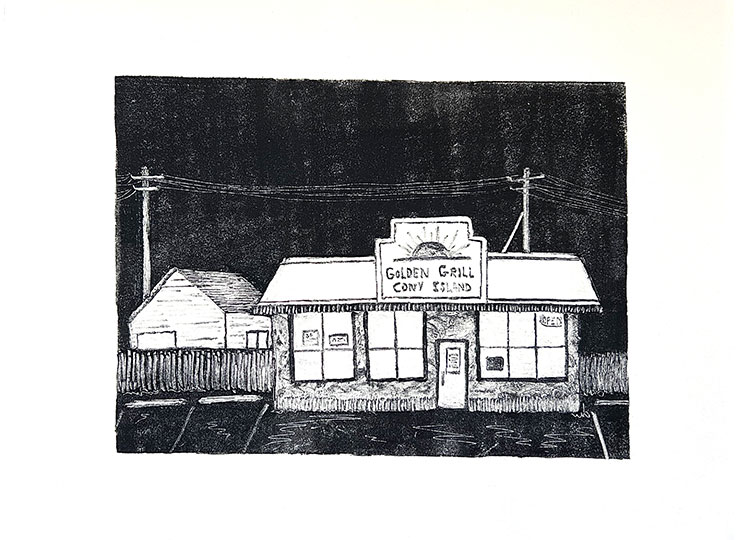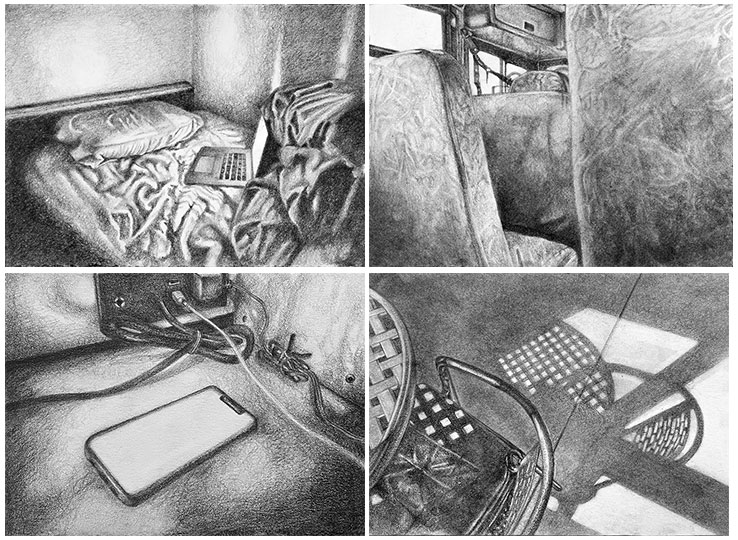Shelley Peterson Student Art Exhibition
2023
The University of Toronto Shelley Peterson Student Art Exhibition is an annual exhibition celebrating the diverse artistic excellence of undergraduate students enrolled in visual studies programs across the University of Toronto’s three campuses. The exhibition offers a meeting place for students to exchange ideas through their diverse artistic practice. Here, you will find more information about each student and their project.
The artists:
Hiu Ting Charlotte Lam | Joy Li | Sophie Woelfing | Xingtian Gong | Huan Chen | Siti Lei | Antonia Grujic |
Suki Wong | Helia Honarmandi | Chloena Kouyoumadjian | Jacob Muller |
Vito Park | Lucy Lin | Billie Raphael | Jinyan Zhao | Jing Han Yang | Natalie R. Chiovitti
2023 Award Winner
Hiu Ting Charlotte Lam
EM
Campus: Mississauga
Year of Study: Fourth
Program of Study: Biology and Art & Art History
Working from a background in design and biology, fourth-year student Hiu Ting Charlotte Lam takes an interdisciplinary approach to the creation of a botanical typeface. The resulting font, “EM,” quotes the found forms and structures visible in microscope slides of plant vascular bundles. Its title references the typographic unit “em” and the last two letters in phloem and xylem, the two core transport structures within vascular bundles.
This confluence of art and science encourages us to look out for the beauty and creativity evident in the natural world, while also disrupting our perception of art and science as distinct categories. These shapes are only visible through the technological development of the microscope, and our understanding of them is grounded in science; however, the artist’s selection of the shapes and their inclusion in the typeface incorporates them in a firmly creative process.
Watch Hiu Ting Charlotte Lam’s video profile here.
Images: Hiu Ting Charlotte Lam, EM, 2022. Digital. Courtesy of the artist.
Sophie Woelfing
Petroglyphic
Campus: St. George
Year of Study: Second
Program of Study: Visual Studies
A second-year student of visual studies, archaeology, and Celtic studies, Sophie Woelfling is interested in the role people play in mediating and influencing their environment. Her work explores the processes that humans have used throughout time to document, categorize, and make sense of the world around them. By juxtaposing the old and natural with the artificial, Woelfling aims to create works that transcend and challenge our established conceptions of time and place.
In Woelfling’s Petroglyphic, past and present collide to inquire about the passage of time and our place within it. Cellular forms, known to us only through the microscope, stretch across a fraying burlap cloth; loosely woven and, in parts, shredded, the textile might be a recently excavated and rapidly decaying archaeological artifact. Both material and pattern are derived from nature, but a history of technology and its impacts is present in the work.
Images: Sophie Woelfing, Petroglyphic, 2022. Oil on Burlap, 20 x 14 in. Courtesy of the artist.
Joy Li
Plant Lessons
Campus: St. George
Year of Study: Second
Program of Study: Visual Studies Specialist- Studio Stream
Joy Li is a second-year student whose artwork draws attention to the interdependence between humans and plants, highlighting the vital role of plants in our lives. By engaging with plants and the processes that sustain them, Li suggests, we become more aware of the processes that support us.
Plant Lessons creates happenings that inspire us to look more closely at the world around us, to appreciate the beauty of the natural world, and to reflect on our place within it. Li’s work shares a deep affinity with Fluxus event scores in the 1960s. Like Fluxus, Li invites participants to engage with the world in an open-ended way, using simple instructions as prompts for exploration. In this artwork, participants are invited to enter a greenhouse and engage with plants personally and intimately. Suggestions for engagement are written on handmade paper—a tangible reminder of the transformative power of art and the natural world.
Images: Joy Li, Plant Lessons, 2022. Mixed Media, 6 x 5 in. Courtesy of the artist.
Xingtian Gong
重拾旧时光 (Old Memories)
Campus: St. George
Year of Study: Fourth
Program of Study: Architecture Studies, minor in Visual Studies
Xingtian Gong is a fourth-year architecture and visual studies student whose practice focuses on merging traditional art with modern techniques. Growing up with her grandfather, she was exposed to a variety of traditional Chinese crafts, of which Chinese painting remains most influential.
In 重拾旧时光 (Old Memories), Gong combines the traditional techniques of cloisonné and sand painting to depict ordinary scenes from memories, such as cherry blossoms in the spring and lotus flowers growing in her backyard during summer. Animation techniques allow Gong to fuse old and new; revealing the stories behind her paintings and offering a glimpse into her Chinese culture and heritage through video, she both preserves the craft of an earlier generation and reimagines it for her own. Gong’s innovative approach explores the potential of new media to complement and enrich traditional art forms as well as to share the techniques with a wider audience.
Images: Xingtian Gong, 重拾旧时光 (Old Memories), 2022. Cloisonne Sandpainting and video, 1 min 43 sec. Courtesy of the artist.
Huan Chen
Trace 1
Campus: Mississauga
Year of Study: Third
Program of Study: Art & Art History
Huan Chen’s artwork aims to recall the beauty of Beijing’s traditional alleyways and courtyards, known as Hutongs, and to examine the ideas of modernization, urban planning, identity, and cultural and historical heritage associated with the alleyways’ rapid disappearance alongside China’s economic growth and development.
Established a thousand years ago, the Hutongs run like veins through the city of Beijing, linking culture, art, folk customs, and legends. Trace 1 commemorates these links through the intense interaction of thin and thick paints, variations in brushwork, smudging, scratching, and trial and error; through layering and reiteration, the artist considers and reconsiders the surface of the canvas. Although the work’s materiality exceeds this digital presentation, the viewer can, newly, gain insight into the artist’s creative process by zooming in on the artwork to explore the nuances of Chen’s intricate brushwork and layering.
Images: Huan Chen, Trace 1, 2022. Oil on Canvas, 36 x 48 in. Courtesy of the artist.
Siti Lei
Absence of Positive History
Campus: St. George
Year of Study: Fourth
Program of Study: Visual Studies and Art History
Siti Lei is a Chinese Canadian artist currently based in Toronto. In Absence of Positive History, Lei reflects on the COVID-19 pandemic and examines its devastating consequences, from political fissures to shattered interpersonal relationships. A concrete block, akin to those used for paving roads in China, is smashed down the centre; the slab is startling and visceral, reflecting the heavy emotional toll of the pandemic. Upon closer examination, one finds test tubes, swabs, and rapid test strips scattered among the rubble, staged as fossils of our era.
Born and raised in China, the artist observed the crisis unfolding and the social stigma inflicted upon individuals who tested positive—they were blamed, socially ostracized, deemed unemployable. Discrimination of this kind was (and continues to be) detrimental to those suffering from the severe unemployment and living crises present in China even prior to the pandemic. The artist boldly fractures the culture of shame that the pandemic has bred, making visible what is so often concealed.
Images: Siti Lei, Absence of Positive History, 2022. Sculpture, 19.7 x 19.7 x 3.9 in. Courtesy of the artist.
Antonia Grujic
Five Mile & Beech Daly
Campus: Mississauga
Year of Study: Fifth
Program of Study: Art and Art History
Antonia Grujic is a mixed-media artist specializing in printmaking from dry point to monoprint. Originally from Metro Detroit, Michigan, she will complete her visual arts undergraduate degree in Toronto this year, where she continues to produce work from her home studio. She often investigates her sense of self, surrounding environment, and engagement with the world through expressive print-based translations of combined photographic references.
Topics surrounding mental health and the artist’s relationship with society are explored and continuously develop as her style evolves. In her latest monoprint series, Five Mile & Beech Daly, Grujic revisits scenes from her childhood in Detroit, depicting images cropped from Google Street View of locally owned restaurants, gas stations, shops, and large franchised stores that surround her family’s business. The empty streets prioritize the artist’s personal experience; we alone join her in the Detroit of her memory.
Images: Antonia Grujic, Five Mile & Beech Daly, 2022. Monoprint. Courtesy of the artist.
Suki Wong
intro-
Campus: Mississauga
Year of Study: Fourth
Program of Study: Art & Art History
Suki Wong is an artist from Hong Kong, currently based in Toronto. She is a fourth-year student specializing in Art and Art History, and, recently, she received the Catherine Quesnel Prize in Art and Art History (2021) and the ARTiculations Art Supply Award for Excellence in Drawing III (2022). Through drawing, she thematizes introspection to explore her relationship to the world.
intro- is an ongoing series of miniature graphite drawings that explore the artist’s perplexing tendency to find comfort in solitude and loneliness. Depicting public and private spaces and, within them, absences, the drawings foreground Wong’s perception of the world and her introverted inclination to avoid social interaction. While displaying the images at a distance from one another to permit the viewer to view each drawing individually, the monochromatic drawings reflect the artist’s distinctive point of view when they are placed closely alongside each other. The small scale, personal nature, and meticulous detail of the images both inspire a sense of intimacy with Wong’s worldview and invite the viewer to contemplate their own relationships with the world.
Images: Suki Wong, intro-, 2022. Graphite on Stonehenge paper, 5.5 x 7.5 in., Courtesy of the artist.
2023 Award Winner
Helia Honarmandi
A Few Strands of Hair
Campus: St. George
Year of Study: First
Program of Study: Visual Studies
Raising awareness for the ongoing protests and human rights conflicts in Iran following the death of Mahsa Amini in September 2022, Helia Honarmandi’s diptych A Few Strands of Hair speaks to the current political dissent and its impact on family, culture, and citizenship, even at a distance. A first-year visual studies student, Honarmandi uses collage and colour splashed across the canvas to depict disruption, bloodshed, and the force of the ongoing movement. She juxtaposes Picasso’s Les Demoiselles D’Avignon, the Qu’ran, and Iran’s Tower of Freedom, among other images, to discuss male privilege, misogyny, and the hypocrisy of freedom in Iran under the current regime. Pasted across both images is the Persian adage “This too shall pass.” Alongside Tehran’s most-read daily newspaper, Hamshahri, the adage reflects on the critical importance of artists and writers, further drawing attention to their unjust persecution.
The black-and-white second panel, while no less vivid, introduces a degree of visual separation to communicate the experience of an Iranian citizen living abroad and witnessing the events without the means to effect tangible change.
Watch Helia Honarmandi’s video profile here.
Images: Helia Honarmandi, A Few Strands of Hair, 2022. Collage diptych, 60 x 150 cm, Courtesy of the artist.
Chloena Kouyoumadjian
1997 Prologue
Campus: Scarborough
Year of Study: Fourth
Program of Study: Psychology and Studio Art
Chloena Kouyoumadjian is a fourth-year psychology and studio art student whose work encourages us to reflect on intimately offbeat moments in our own lives. 1997 Prologue celebrates the eccentric beginning of her parents’ relationship by depicting their first date at a casino.
Taking inspiration from Nijdeka Akunyili Crosby’s paintings that feature photographic transfers related to familial memory, Kouyoumadjian utilizes similar phototransfer techniques to subvert conventions in painting by drawing the viewers’ attention to the unique construction of the work. Gel pen adds a nostalgic, shimmery gleam that disrupts the artwork’s tendency towards hyperrealism, while the disjunction between photo transfer and painting simultaneously situates the couple within the casino and isolates them from their surroundings. The artist memorializes a casual yet candid moment that captures the affection the new couple has for each other and their shared love of poker. Locating this romance—with its familiar charm—in a casino subverts the negative connotations of that environment. Kouyoumadjian explores the potential of humour and warmth in inspiring us to ponder our own personal connections.
Images: Chloena Kouyoumadjian, 1997 Prologue, 2022. Photo transfer, paint, gel pen, crayon, 16 x 24 in. Courtesy of the artist.
Jacob Muller
A rich poor image is still a poor image
Campus: St. George
Year of Study: First
Program of Study: Architectural Studies
Jacob Muller is a first-year architecture student who approaches his creative practice with an open and interdisciplinary mindset. As an artist, Jacob explores the intersection of art and spatial design, drawing from his fascination with visual studies. His current body of work revolves around the theme of family, and he engages with physical mediums such as collage, ink and graphite drawing, and painting.
In A rich poor image is still a poor image, Muller delves into his grandparents’ traumatic experiences, tracing their survival amidst genocide, military involvement, immigration to Canada, and internal conflict. Muller’s works are visually stunning and deeply emotional, reflecting the pain and resilience of his ancestors. His works’ materiality contrasts with the increasingly digitized nature of our memories, arguing for the potentially unique capacity of the tangible for capturing the depth of human feeling. Muller’s emphasis on physicality and his exploration of the limitations of digital media might pose an open question about his works’ and others’ virtual translation and display.
Images: Jacob Muller, A rich poor image is still a poor image, 2023. Mixed media, 40 x 15 in. Courtesy of the artist.
Vito Park
Karuna (Interpretive Illustration no. 3)
Campus: St. George
Year of Study: First
Program of Study: Visual Studies and Music
Vito Park’s artistic practice centres on exploring the dynamic relationship between the artist and the viewer. How does a viewer’s knowledge, perspective, and cultural background impact their understanding of an artwork and of an artist’s ideas?
Karuna (Interpretive Illustration no. 3) presents an amalgamation of Catholic and Buddhist imagery, referencing two distinct cultural and religious traditions by invoking their symbols, protagonists, and famous artworks. The central f igure represents Guan Yin, a prominent Boddhisattva associated with compassion; the seated posture, multiple arms, and position of the hands are all recognizable attributes of this figure. However, the work also recalls the Annunciation by Leonardo Da Vinci (c. 1472); Italian Renaissance oil painting informs Park’s style, and the chests, cornerstones, and dress of the figure are lifted directly from the Annunciation. Guan Yin could, thus, be identified as the Virgin Mary, a prominent f igure in the Christian faith. The meaning of the work is dependent on its viewer’s perception.
Images: Vito Park, Karuna (Interpretive Illustration no. 3), 2021-2023. Oil on canvas, 16 x 20.5 in. Courtesy of the artist.
Lucy Lin
<Cocoon>
Campus: St. George
Year of Study: Second
Program of Study: Visual Studies Specialist – Studio Stream, with a minor in Art History
In <Cocoon>, artist Lucy Lin explores themes of female identity and the struggle to break free from traditional cultural norms and expectations to find renewed freedom and individuality.
This powerful digital series comprises three images that sequentially illustrate the journey of a young Chinese woman as she liberates herself from traditional societal expectations, ultimately experiencing a profound rebirth. The first image shows the woman kneeling with Chinese words written on her body, symbolizing the constraints placed upon her by an older generation. In the second image, she begins to untangle herself from these restrictions; her struggle is emphasized in three distinct movements. Finally, in the third image, a series of joyful expressions break free in monochrome from the woman’s neatly made-up face, now cracked in half. Lin discloses the difficulties of challenging traditional cultural norms, and she urges viewers to explore their own comprehensions of identity beyond the confines of societal norms and familial expectations. How might one embrace individuality, she asks, while acknowledging cultural roots?
Images: Lucy Lin, <Cocoon>. Photography, triptych. Courtesy of the artist.
2023 Award Winner
Billie Raphael
Birthed Right
Campus: St. George
Year of Study: Fourth
Program of Study: Specialist in Visual Studies: Studio Stream and Major in Architectual Studies
Billie Raphael is a Filipino multidisciplinary artist, often depicting the minutiae of queerness and its quotidian indulgences. Their work has been featured in publications including POSTMOD (2019), Shift Magazine (2020), and ENBY Magazine (2021).
Birthed Right explores queerness as rebirth. Gender fluidity is explored as the body shifts from one state of being to another, constantly in flux. In this physical, gestural performance, the body enacts its will on itself. This idea of rebirth is evoked with vivid pelvic imagery, as colours are used to reflect exaggerated shades of viscera. Two arms protrude from the couch, physically manifesting the bodily intervention, reflecting how gender presentation is based on performance through small gestures that intervene with others’ perceptions of one’s body. Lycra is used to reflect a slippery quality, while the yarn and fur play with expectations of innards as things that are wet, alive, or biotic, heightening the object’s artificiality. Originally made to be engaged with, the stuffing inside the work is made to shift and bulge in accordance to how a person interacts with it.
Watch Billie Raphael’s video profile here.
Images: Billie Raphael, Birthed Right, 2022. Lycra, yarn, polyester, 112 x 98 x 20cm. Courtesy of the artist.
Jinyan Zhao
Am I Pink Silly Putty
Campus: St. George
Year of Study: Third
Program of Study: Specialist in Visual Studies – Studio Stream
Jinyan Zhao is a Chinese multidisciplinary artist who is based in Toronto. Through her artistic practice, her dizzying and abstract inner world becomes tangible. Using her personal experiences as a lens through which to operate, the artist combines various mediums like photography, peJinyan Zhao is a Chinese multidisciplinary artist based in Toronto. Through her artistic practice, her dizzying and abstract inner world becomes tangible. Using her personal experiences as a lens, the artist combines various mediums like photography, performance art, sculpture, and installation to interrogate fraught and complex issues of gender, misogyny, and sexuality in the patriarchal digital age.
Utilizing an ironic pink fetishistic aesthetic, Am I the Silly Putty? is a hypnotic five-minute video installation that depicts a woman (the artist herself) playing with, consuming, and eventually becoming pink silly putty—or vice versa. The voiceover is unsettlingly childlike; frenzied movements grow increasingly chaotic throughout the work, eventually exploding into a kaleidoscopic montage of body parts and putty. Inspired by a drunken conversation on the male gaze between the artist and her friends, the film depicts a woman grappling with and questioning how her female body and mind are digitized, becoming a twodimensional consumable product to be packaged, manipulated, degraded, and distorted. Attempting to maintain some semblance of agency and personhood, the woman opts to destroy her body herself.
Images: Jinyan Zhao, Am I Pink Silly Putty, 2022. Film, sculpture, installation, 5 min. Courtesy of the artist.
Jing Han Yang
Second Hand Breasts
Campus: Mississauga
Year of Study: Fourth
Program of Study: Art & Art History
A multi-media artist, student and instructor, Jing Han Yang’s Second Hand Breasts uses viewer participation and the human body as a medium to explore ideas of gender and body modification. Jing Han Yang creates pieces that demand the attention and contribution of the viewer by inserting them directly into the work and centering their perspectives rather than those of the artist.
Posting an image of their breasts around Toronto and online, Yang asks viewers to scan a QR code and answer various questions about their thoughts on their gender and whether they would be interested in a “boob swap/trade” and why. Answers range from jokes about not knowing what to do with two sets of breasts to a heartfelt discussion about the responder’s own relationship with gender. The survey prompts a consideration of gender identity and presentation and identifies the viewer’s perspective and thoughts as integral to the work itself.
Participate in the artwork by following the link or scanning the QR code:

Images: Jing Han Yang, Second Hand Breasts, 2021. Silkscreen on paper, QR code, survey, 3 x 3 in. Courtesy of the artist.
Natalie R. Chiovitti
Lenses
Campus: Mississauga
Year of Study: Fifth
Program of Study: Art & Art History and Communication, Culture, Information & Technology
Natalie R. Chiovitti is a visual artist and graphic designer working across disciplines including drawing, design, illustration, projection, photography, and installation. Interested in such themes as pop culture, social engagement, community, sustainability, and human experience, she is the 2022 recipient of the Women’s Art Association of Canada Helga Scott Scholarship and the Excellence in Design 3 Art and Art History Faculty Award. Chiovitti’s 2022 work Lenses utilizes both visual metaphor and augmented reality (AR) to provoke questions about our relationships to each other and to sustainability. A central f igure wears three pairs of sunglasses, or “lenses,” representing three different perspectives on sustainability: social, environmental, and economic. Presented as discrete objects, these lenses prompt questions as to whether and how these three perspectives can work together. A QR code allows the viewer to enter the AR world of the artwork; surrounded and grounded with images of plants and flowers from the artist’s garden in Mississauga, the viewer joins the illustrated figures in the search for a collective, sustainable future.
Experience the work in AR on Adobe Aero by scanning the QR code:

Images: Natalie R. Chiovitti, Lenses, 2022. Digital drawing on printed paper and augmented reality, 2550 x 3300 pixels. Courtesy of the artist.
Maxen Wang
Navigation
Campus: St. George
Year of Study: Third
Program of Study: Architectual Studies, majoring in Visual Studies
Maxen Wang is a Toronto-based digital multimedia artist attempting to locate and shape the abstract. Invoking the seduction of the unseen or hidden, Wang taps into the ancient and human while simultaneously exploring the new spatial order that has emerged from the fusion of the virtual and physical.
Navigation explores our positionality as new digital seafarers, virtually journeying across time and space. Given the increasingly immersive nature of virtual experience we might feel that our bodies inhabit the imaginary and designed projections of the mind. This represents a change in how humans experience the world, transforming the way we understand ourselves and our place in the world. This shift echoes throughout different cultures, providing relevance to ancient myths of mystical journeys. For Wang, the contemporary art of cyberspace is a navigational art, a unifying force within the new state of the biosphere. He urges us to listen to and rediscover the creative and inspirational power of long-forgotten and ignored cultures. The navigational star shining bright in the distance is a projection of the fractal geometry of ancient African design brought back to light.
Images: Maxen Wang, Navigation. Digital drawing. Courtesy of the artist.
Gladys Lou
Am I Human?
Campus: Mississauga
Year of Study: Fourth
Program of Study: Art & Art History
Gladys Lou is a Canadian artist and writer from Hong Kong whose practice is focused on experimental media. She is currently completing a Bachelor of Arts in Art and Art History, with a double major in Psychology and a certificate of Curatorial Studies. Mobilizing video, sound, and performance, Gladys integrates the visual arts with multisensory experience. Thematic explorations of identity, mental health, and existentialism are combined with prose to examine the unconscious and issues of accessibility. Central to her practice are issues faced by BIPOC and 2SLGBTQIA+ individuals suffering from mental illness.
Am I Human? employs video and sound in a post-human exploration of data, artificial intelligence, and surveillance. On-screen glitches disrupt communication and represent the artist’s attempts to grapple with the experience of being human within a normative culture. Inspired by representations of human beings throughout the ages, Lou questions the accuracy of machine learning algorithms. The disorienting speed of the video correlates with media bombardment, data infiltration, and the overwhelming, almost claustrophobic influence of digital technology in every facet of our lives. With this in mind, the artist critiques the precarious relationship we all have with the digital world.
Images: Gladys Lou, Am I Human?, 2022. Digital multimedia, 1 min 28 sec. Courtesy of the artist.
Credits
Images and audio/video clips all courtesy of the artists.
The 2023 University of Toronto Shelley Peterson Student Art Exhibition is curated by Jessica Fisher, Meredith Lorimer, and Neshan Tung as part of their Master of Museum Studies Exhibition Project at the Faculty of Information, University of Toronto. Their project mentor is Dr. Liora Belford.
Our Supporters
We gratefully acknowledge project support from the Office of the Vice-President & Provost; University of Toronto Affinity Sponsors Manulife and TD Insurance; and the University of Toronto Faculty of Information.


2023 Award Winners and Juror’s Remarks
Congratulations to artists and curators on the 2023 edition of the Shelley Peterson Student Art Exhibition! It has been an honour to adjudicate these artworks and to ponder our contemporaneity more deeply. This year’s entries represent the various ways in which borders are breached and resisted, be they digital, biological, cultural, political, social, or disciplinary. As records of temporality, these works map our changing cosmos across multiple realities. So much of life has been and continues to be lived online, and this exhibition bridges these spaces where real and screentime blur, becoming inseparable.
The award winners this year engage with ideas centred on movement: botanical transport systems, fluid notions of gender, and the mobilization of protest. In their own way, each artwork navigates being in the world, where beauty and becoming in nature meet human-generated injustice. As disparate as these themes may appear, they serve as reminders of our interconnected and dynamic ecosystem, and how we negotiate daily with the planet and each other. These works embody the difference and diversity present in everyday life, whether situated in digital space, on Indigenous lands, or home abroad. If the past three years have taught us anything, it is that many individual and collective realities co-exist at any moment, in simultaneous alternate universes both separate and together.
Charlene K. Lau
2023 Juror
Back to 2023 University of Toronto Shelley Peterson Student Art Exhibition














